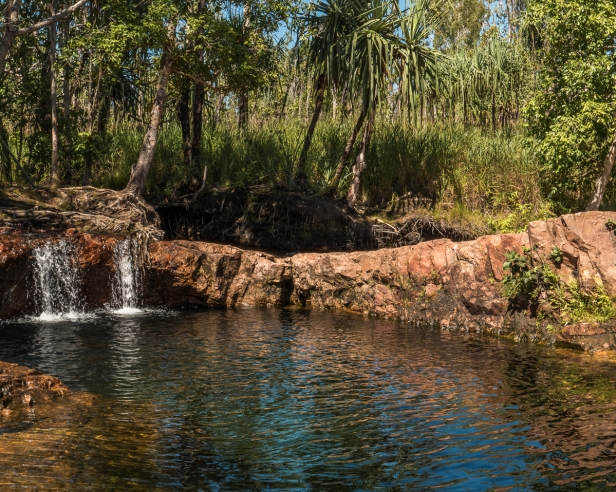
24-27 April 2015. From the village of Batchelor we drive to the Banyan Tree Caravan & Tourist Park in Rum Jungle. It’s about a fifteen-minute drive out into the middle of nowhere. Batchelor is a dusty rambling little town with no apparent main street, and a population of about four hundred. It’s already in the middle of nowhere, out whoop whoop as the Aussies say. The Banyan Tree Caravan & Tourist Park is further out whoop whoop with nothing around it but grasslands and a few trees.
Rum Jungle is a district that’s pretty much uninhabited. There used to be a uranium mine somewhere close to Batchelor, and now there are three caravan-and-camping parks a few kilometres apart, but there’s nothing much else there.
Long before the uranium mine, back in the 1880’s there was a railway line that ran south from Darwin, with a station at Rum Jungle although it wasn’t known as that. There’s not much left there today but the name. In the late 1890’s the John Bull gold mine was at its peak. Some miners arrived in the district carrying 750 ounces of gold. They met a teamster who bragged of his cargo of rum, and generously shared it around. When the miners had passed out from the rum the teamster made off with their gold and their horses. He was caught months later, and no doubt punished for his sins. His heritage is one of Australia’s more colourful place names.
The Banyan Tree Caravan Park is all a bit shabby; old, tired and dusty, and I’m really glad we aren’t actually camping there, but we are well welcomed. Our cabin, one of several in a row, lacks even the remotest hint of elegance, and features peeling wallpaper and orange plastic chairs, but it has all we need for three nights, and there is a pool for us to cool off in. Most importantly it is on the road to Litchfield National Park, the next stop in our explorations of the Northern Territory.
The Litchfield we discover is all monsoon rainforests, flowing water, plunge pools, waterfalls, hiking and swimming. Greenant Creek to Tjaetaba Falls, a climb up over the top of Wangi Falls, water everywhere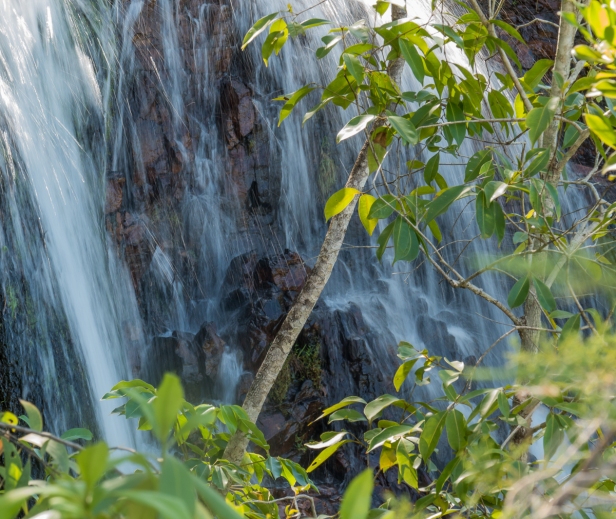
and spiders,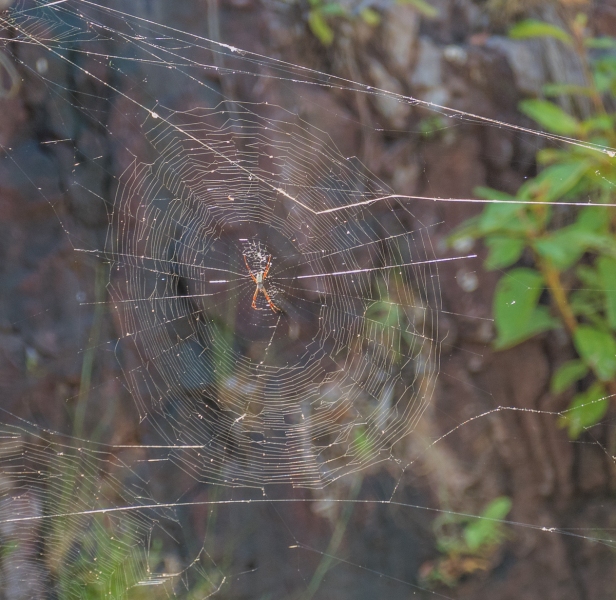
and a shy, almost hidden Rainbow Pitta bird.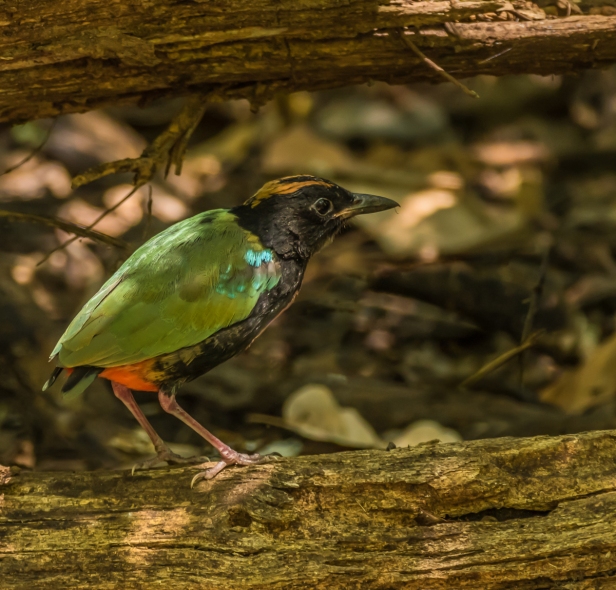
It’s a liquid kaleidoscope of red rocks, green forest, blue sky and rippling waters.
Buley Rock Pools is a seemingly endless cascade of river and deep pools stepped down one after the other. We swim there one day, but the next day is a Saturday. We couldn’t even find a parking place. All of Darwin had escaped the city to swim and picnic at Buley Rock Pools.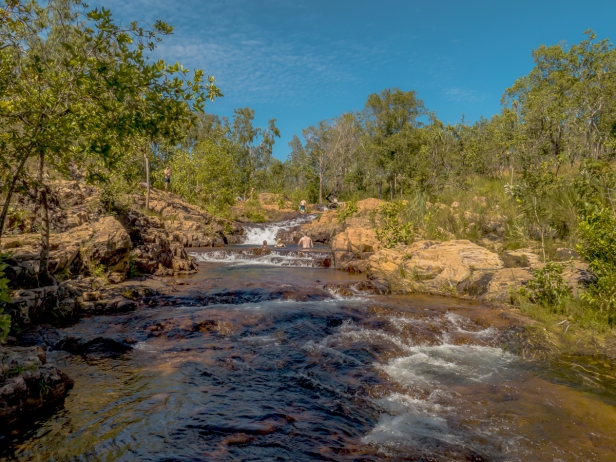
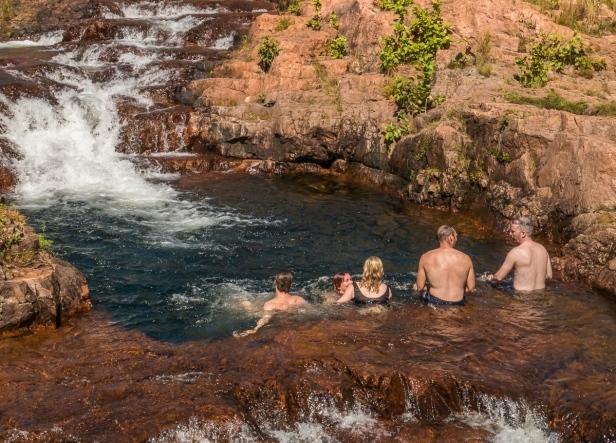
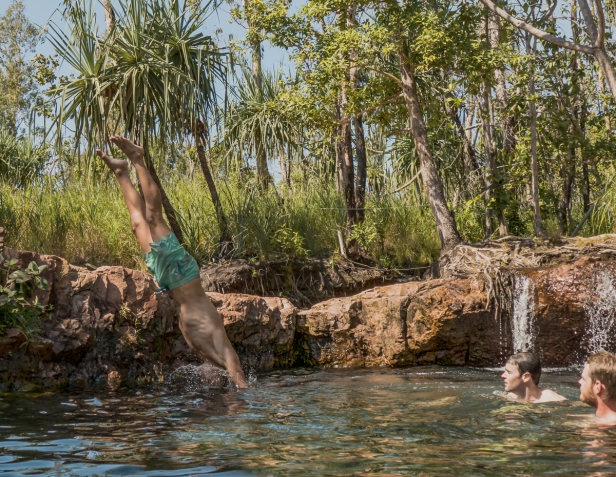
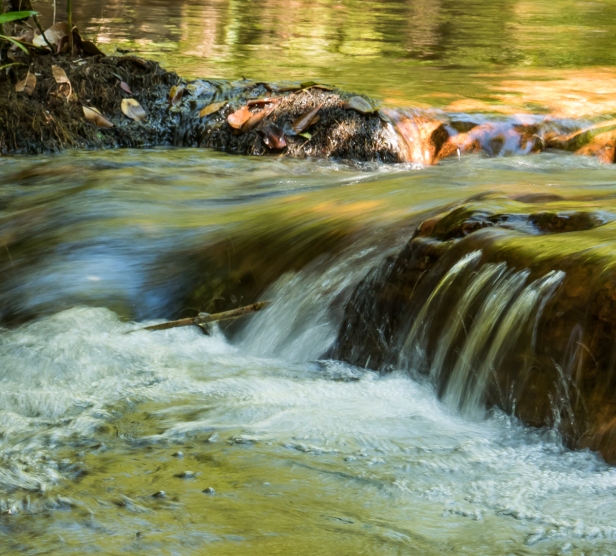
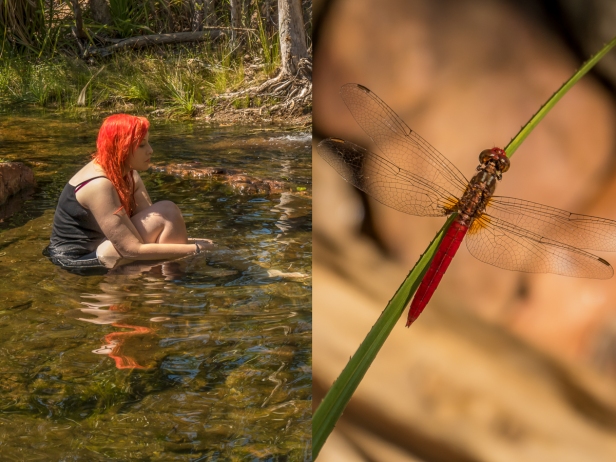

We hike for an hour or so alongside Florence Creek from Buley to Florence Falls, a spectacular double waterfall.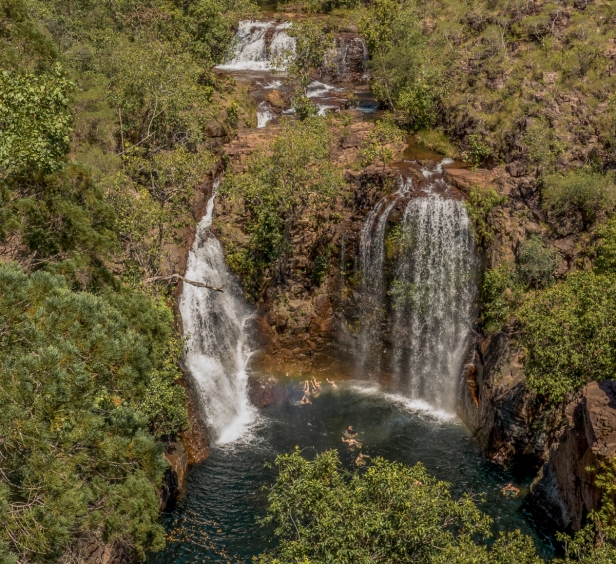
You can climb the 120 steps down to the pool from the car park above, or hike from Buley as we did and arrive right at the pool.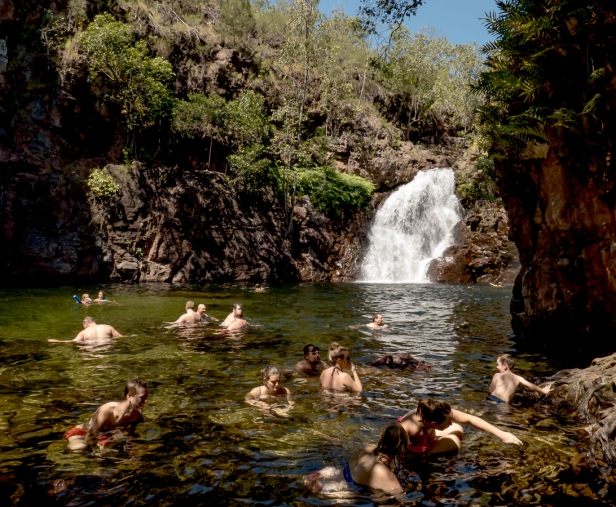
The first thing that attracts my attention at Florence Falls is not the pool, or the waterfalls. It is this: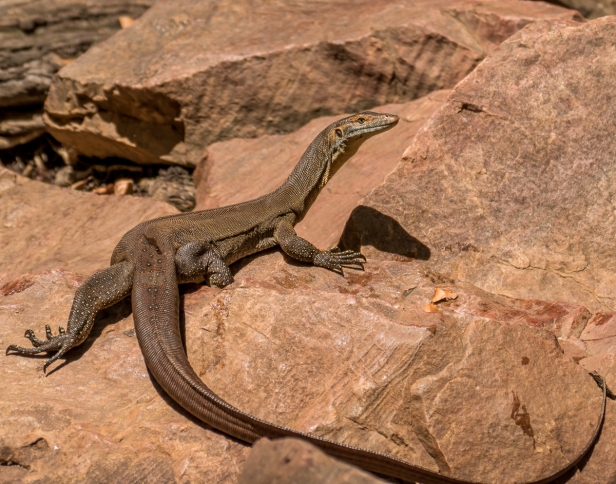
It’s a monitor lizard, about three feet long, or maybe more. It’s hunting around in amongst the rocks by the river that flows from the falls.

Ha! Dinner! They are so fast. I watch as it moves around the rocks, in and out of the little pools of water at the edge of the river, its forked tongue flashing in and out. Suddenly it snaps forward into a pool and catches dinner. There is no mercy in nature.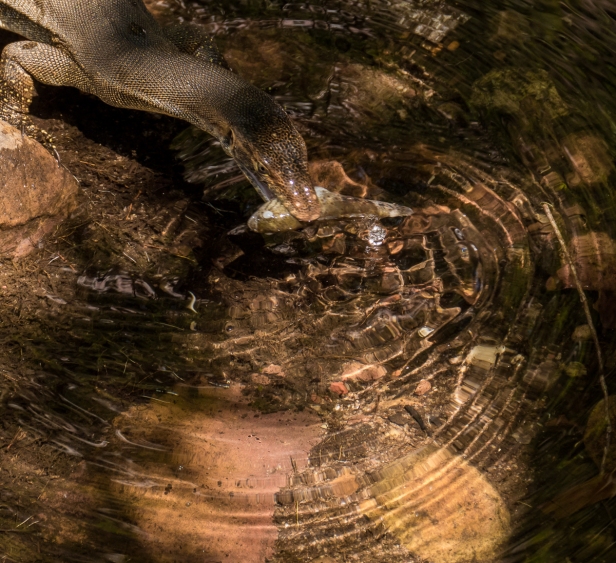
One of the most extraordinary, if not visually spectacular things we see in Litchfield are the magnetic termite mounds. Unlike the enormous cathedral termite mounds seen elsewhere in the north, magnetic termite mounds only grow to a height of up to two metres and are thin wedges. They are all aligned north-south.
From the signs at the site: For a delicate little insect magnetic termites (amitermes meridionalis) live in a pretty tough environment, temperatures soar during the day and plummet at night, and everything gets sodden in the Wet Season.
Many species of termites escape extreme temperatures by burrowing underground but this is not an option for the magnetic termite. A home above ground is required, safe from the annually waterlogged soils of the Wet Season. Food for the colony must be well protected from bacteria and fungi. The smart structure of these mounds keeps the termites above the water table in the Wet and provides them with sufficient space for well-ventilated food storage near the mound’s surface.
Living in a wedge-shaped tower may be great for food storage but if the tower is oriented to catch the sun’s heat it can become a solar cooker. Scientists conducted experiments and found that when the alignment of the mound was changed the temperatures inside the mound rose significantly. To avoid this problem the termite mounds are aligned to use the sun to balance the internal temperature and ensure the optimum conditions are maintained. By aligning in a north-south orientation one side will always be in the shade.
The termite mound builders are little Worker termites. As they are completely blind scientists can be sure they do not use the sun to guide them in building to a north-south alignment. It was suspected that they have an inbuilt compass to guide them. To test this theory scientists artificially changed the direction of the magnetic field using magnets. The termites dutifully followed and built repairs to their mound in the alignment of these magnets and not to the Earth’s magnetic field.
Nature never ceases to amaze me. An army of tiny insects each with an internal compass. Really, it’s quite extraordinary.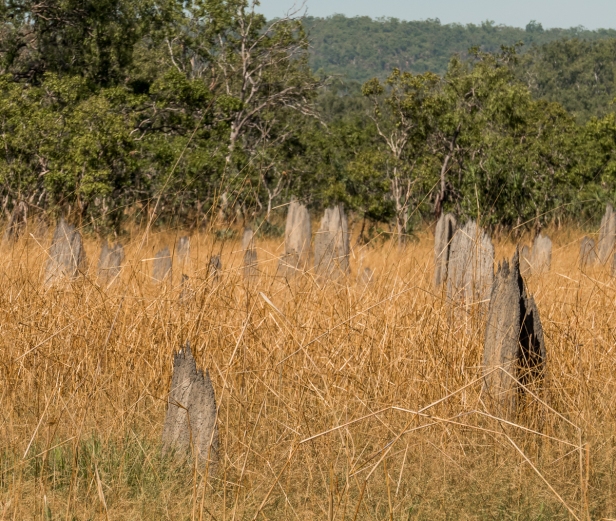
******************************
So we’re in a boat cruising down the Adelaide River about an hour’s drive from Darwin. We’re inside the boat, downstairs, next to an open window. Holy leaping crocodiles Batman! Suddenly this comes jumping out of the water right next to the boat: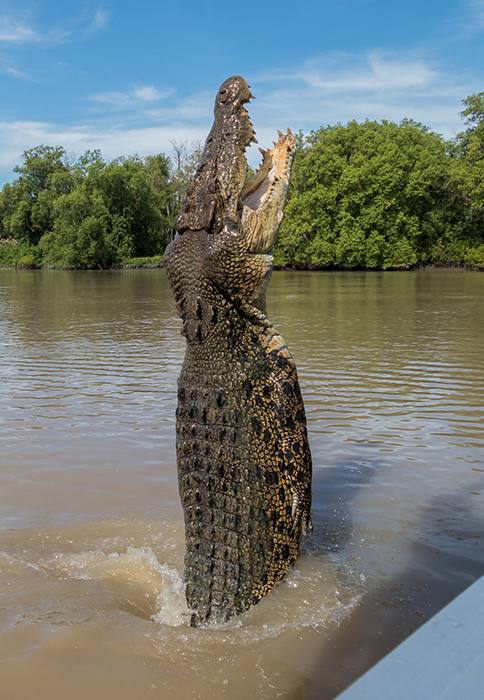
Soon we see another in the water. The great grandfather of all crocodiles!
Then another comes leaping out of the water.
Above us on the open top deck of the boat, standing on a small overhanging fenced platform, a young woman is tempting crocs by dangling a bundle of raw meat.
Actually there are two young women, one on either side of the boat, taking turns to dangle temptations to whatever crocs may be around. They’ve been doing it for years. Long enough that they recognize some of the crocodiles, though there’s no knowing which ones will show up on any given day, if any.
It’s pretty busy in the middle of the river. The kites can smell the meat too and there are several of them overhead.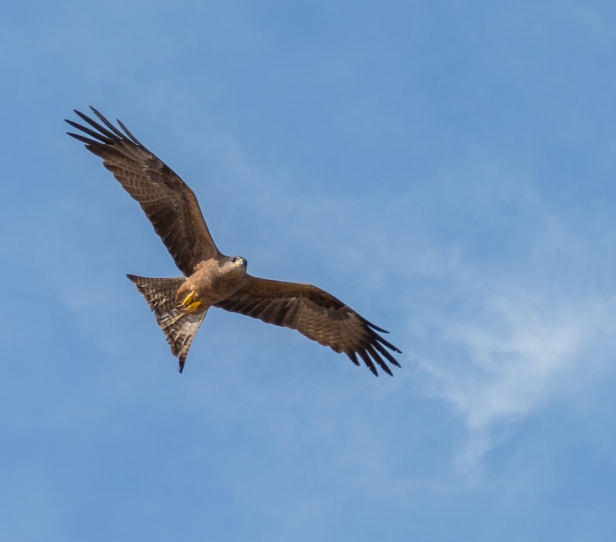
Suddenly, as a kite dives at the meat, a crocodile leaps out of the water to grab it. The crocodile wins. The kite escapes with its life, though I’ve seen a photo online of a crocodile leaping out of the water and catching a magpie goose for dinner.
Crocodiles are truly prehistoric, having existed unchanged for nearly two hundred million years. They are also the largest living reptile in the world and can grow to a length of five metres or over sixteen feet. In the Northern Territory three people have been killed by crocodiles in the past year. One was a local man fishing not five hundred metres from the cruise boat dock on the Adelaide River. He fished there often. Crocodiles can stalk their prey for up to a year before attacking. It’s likely that the crocodile that took this fisherman had been stalking him for a while. They are also opportunity hunters. There is no mercy in nature.
There are over 80,000 crocs in the Northern Territory, with as many as 10,000 in the Adelaide River system. Seeing a croc jumping is extremely rare. Jumping is how they take their food. With the exception of the Jumping Crocodile Cruise, if you do see a crocodile jumping you’ll never see it again.
This is the last post about our time in the Top End. I’ll finish with a couple of photos of Darwin’s lovely Mindil Beach. It’s a beautiful beach to play on, and to watch the sunset, and to splash in the shallows with the dog,
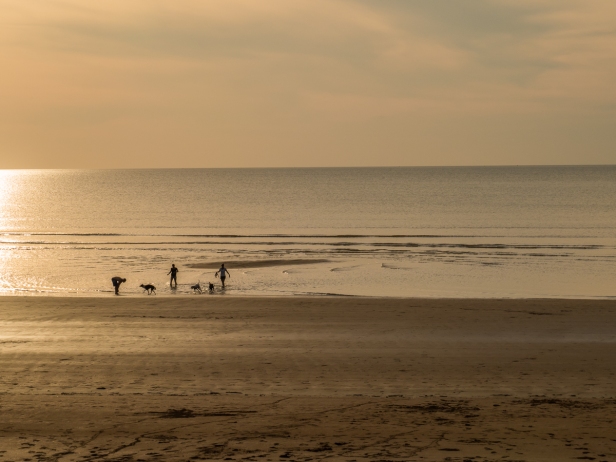
but don’t even think about swimming there, because crocodiles. And sharks. But you don’t need to worry about the sharks. The crocs eat them.
Other posts about the Top End, the northern part of Australia’s Northern Territory:
Too Many Crocs And Not Enough Water
Yellow Water and Fogg Dam in the Top End
An Ancient Culture in an Ancient Land
Water World with Bats, Pythons, and Crocodiles
All words and images by Alison Louise Armstrong unless otherwise noted
© Alison Louise Armstrong and Adventures in Wonderland – a pilgrimage of the heart, 2010-2015.

“a liquid kaleidoscope of color” – what a great description! Beautiful photos.
LikeLiked by 1 person
Thanks Kay. It was a magical time in the Top End. Beautiful landscape and wildlife.
Alison
LikeLike
Lucky you guys. We got our first blast of winter last night here in North Bay Ontario.
LikeLiked by 1 person
Well I do agree we were very lucky to get to explore this part of the world, but we’re back in Vancouver now. We were in Australia way back in April – the blog is always months behind. Sigh. We’re expecting our first blast of winter in the next day or two – Arctic air and snow warning. Brrrrrr.
Alison
LikeLike
holy molie
practically needed
the protection
of batman
from the extreme
presentation of beasts,
people and other natural
beauties graphically expressed 🙂
LikeLiked by 1 person
Chuckle chuckle chuckle.
Thank you.
People and other natural
beauties quite safe.
Batman to the rescue when
threatened by beasties!
Alison
LikeLike
Omg those crocodiles! Scary!
LikeLiked by 1 person
Yes really! Very scary. They were always on our minds where ever we went up north, especially it being at the end of the Wet. During the Dry the waters have fallen way down and the crocs are confined to the rivers pretty much.
Alison
LikeLike
A fascinating read and wonderful pictures! 🙂
LikeLiked by 1 person
Thanks so much Chris. I’m glad you enjoyed it. It’s a fascinating place that’s for sure.
Alison
LikeLiked by 1 person
O.M.G. I thought the bats and snake were nasty, then come the crocs stalking humans (an image that has remained in my mind for over 24 hours now) and the monitor lizard. I am not destined to walk that part of the earth, and now I know why.
LikeLiked by 1 person
Pam, you need to develop a love of wildlife! Snakes bats and crocs especially! Just kidding. Sorry to put that image into your head. I hope it fades soon. Just go to your happy place 🙂
There is so much beauty in this part of the world, and really the number of people who are harmed by wildlife is minuscule. And kangaroos and wallabies are really cute 🙂
Alison
LikeLike
My happy place does not contain reptiles, for sure.
LikeLiked by 1 person
Your pictures are fantastic!! I loved being on this trip with you today. They way you described it, I felt I was there. Oh to be around all that water. That lizard was a very cool dude, and those crocs! Wow! Great captures with your camera! Keep having fun!
Peace,
Mary
LikeLiked by 1 person
Thanks so much Mary. I’m always so pleased when someone says they felt like they were there. It means that I’ve managed to share the experience. It was wonderful being around all that water. There was an abundance of water around every hike we went on. We were walking all through it at the top of Wangi Falls. I’m glad we went at the end of the Wet, and not in the middle of the Dry. I was so excited to see the lizard. Any close encounter with wild life is exciting for me. Except the dangerous ones. Like crocs. And how wonderful to be able to see them the way we did in safety.
Alison
LikeLike
PS. And that bird!!! Beautiful.
LikeLiked by 1 person
Yes, beautiful! A lucky capture. I’d never even heard of rainbow pitta birds. I’m always alert for movement in the bush when we’re hiking.
Alison
LikeLike
Clearly, I’m quite impressed with this post because here I go again. The action shots of the animals and kids!! Ok, enuf.
LikeLiked by 1 person
Thank you. I’m glad you enjoyed it so much. Smiling.
Alison
LikeLike
Love the metallic color in that little bird – you are completely right about nature’s surprises. Happy and safe travels – Susan
LikeLiked by 1 person
Thanks Marsha. Yes, I’m constantly blown away by nature. And the Rainbow Pitta bird was an unexpected delight. A little rustling in the bush and there it was. So pretty.
Alison
LikeLiked by 1 person
Just SOOO beautiful. Thank you so much yet again for sharing your magical travelling experiences.
LikeLiked by 1 person
Thank you Ros. And you’re welcome! Yes – sooooo beautiful. We *loved* the Top End. Neither of us had been there before and we discovered one delight after another. Did you get to Buley Rock pools when you lived up there?
Alison
LikeLike
No I didn’t, Alison, and I can’t believe after nearly 4 years of living there and looking around that you’re now showing me the Top End that I’ve missed out on. Simply fabulous.
We’re in Brussels and London for 3 months with family. Oh dear, your latest blog is making me feel just a little bit homesick already. I’m really missing the bird life, the reptiles and our family of water dragons in Burra, hoping cats haven’t got all the babies just emerging when we left.
Thanks as always for bringing so much pleasure into my life with your wonderful blogs.
LikeLiked by 1 person
Have a wonderful time in Brussels and London! Even if you’re a bit homesick , it must be lovely to be having some family time. And being in Europe!
Blessings, Alison
LikeLike
Holy leaping crocodiles indeed – I can imagine myself clutching my chest and swallowing a scream! And the monitor lizards… the magnetic termites … pools and waterfalls and sheer beauty. Your posts about Australia are a celebration of a weird and wonderful country that I can’t wait to visit. Anita
LikeLiked by 1 person
Thanks Anita. I hope I’ve managed to convey something of the wonder if it all. It’s an amazing country. I do hope you get there one day. It’s definitely worth visiting.
Alison
LikeLike
Wow those croc pictures are unbelievable Alison! To jump straight out of the water like that! Amazing! Looks like such a beautiful park.
LikeLiked by 1 person
Thanks Nicole. That was a fairly amazing day altogether. It was the day we first went to Fogg Dam and saw the Jabirus and all the other birds so close, and then went on to the Jumping Crocs Cruise. Spectacular. And yes, Litchfield is very beautiful.
Alison
LikeLiked by 1 person
How long were you in Australia? I’d love to tour around there. I’ve only spent two weeks and it definitely wasn’t enough.
LikeLiked by 1 person
I was actually born there, and lived there until my early 20’s when I started travelling a lot. Early 30’s I immigrated to Canada. Don and I have been there several times, usually for a couple of months or so, and always combine the visit with spending time with family and exploring the country. This last visit we were there for 5 months I think it was, except for the 5 weeks we spent in NZ.
Alison
LikeLiked by 1 person
Wow how wonderful Alison. 🙂
LikeLiked by 1 person
Out whoop whoop… sounds like my kind of place, Alison, wherever it is. My favorite: the close up of the water running over the rock creation a mini-waterfalls. –Curt
LikeLiked by 1 person
I think you would love out whoop whoop where ever it happens to be 🙂
That photo is also one of my favourites for sure. Each time I look at it I’m kind of transported, and thrilled that I managed to take such a photo. Sweet.
Alison
LikeLike
As you should be, Alison. —Curt
LikeLiked by 1 person
This post had me cringing and flinching! First, the mother in me cringed to see the guy diving into the pool (which is obviously deeper than it looks), then I flinched at the sight of the monitor lizard. There is something about those guys that really creeps me out, even more so than the crocs, which were the final source of my jumpiness (related to theirs own leaping jaws, I suppose!). Lest you think my repeated recoiling spoiled the post for me, let me assure you that I LOVED it! Your photos were gorgeous as always, and I experienced my usual sense of awe as I followed your journey.
LikeLiked by 1 person
Thank you so much. I’m so glad to hear you enjoyed the post despite cringing, flinching, and jumping! 🙂
I must say watching the diving into the pools worried me a bit at first until I realised they are really deep. Lizards don’t bother me at all. I think Monitor lizards are kinda cute. As for the crocs – I never want to get any closer than I did, and only then from the safety of a boat, but I am glad I got that close. It was really exciting.
Alison
LikeLiked by 1 person
Was the teamster’s name Batchelor, or was he a batchelor? I liked the view of the waterfall beyond the leaves. The spider. And you nailed that bird again. But my favorite was the monitor. I have some kind of affinity to those lizards with tongues like that. Not crocs, though. Crocs are just creepy. “No mercy in nature”…I guess, and maybe since we are part of nature, things are, as Don believes, right in the world.
LikeLiked by 1 person
Ha ha – yeah the teamster’s name was Batchelor. I lie. I have no idea what his name was. I loved seeing the monitor – so unexpected, and ‘available’ – he was there for a long time and not hiding or running away at all. I don’t find the crocs creepy as long as I know I’m safe from them. I was on high alert almost all the time we were hiking anywhere near water. Not that it would have helped they are so fast.
I too believe all is right with the world because I believe in the balance of duality. So for all the ‘bad’ there’s an equal amount of ‘good’. I choose to focus on the good – you’d be amazed at how prevalent it is if you turn away from the so-called ‘news’ which I believe is designed to keep us afraid, and focus on the good that’s happening all around the world. Canada has a new bold open-hearted Prime Minister. Did you notice. Maybe it’s catching!
Alison
LikeLike
you must have some kind of calming affect on animals…they seem to let you photograph them and not fly away, even pose!
Politics: no, I don’t notice things like that. But I hope he’s good for you and the world.
LikeLiked by 1 person
Yes, he’s both. He’s a good man who won’t be bullied.
LikeLike
well OK then…good on yer! you’re ahead of the rest of us!
LikeLiked by 1 person
Jumping crocodiles, termites with internal compass, nature always has its way to surprise us, doesn’t it? And from nature we learn how things work, and how they can make our lives better. But more often than not we take nature for granted, forgetting that without a healthy planet our lives will only get worse.
LikeLiked by 1 person
Yes, nature is amazing that’s for sure. And it’s sad that many people take it for granted, and worse, but I am an eternal optimist that nature, including us humans, will heal itself. There are so many good projects happening around the world, most notably the shift to clean energy in several countries. It’s only the bad news that gets reported. If the emphasis of all the news media shifted from focusing on all that is wrong in the world to focusing on all that is right we would all see a completely different world.
Alison
LikeLike
We are partly to blame for all the bad news in the media. If all news is good news, would we bother to care? If it’s bad news, we will watch TV, buy newspapers, which eventually create business for the media industry.
Anyway, I do believe there are still a lot of good people on earth — enough to keep madness at bay. Although sometimes madness is hard to contain. But there is always hope, and kindness.
LikeLiked by 1 person
Yes, I know – if it bleeds it leads. People are addicted to drama it seems. If it was all good news would we bother to care? – of course we would! I guess I’m a Pollyanna – I have an unshakable belief in the basic goodness of humankind. And I believe there are far more ‘good’ people than those who are confused and perhaps a little insane. As you say there is always kindness. And humour. Look at the way the Belgians responded to the terror threat! It brought tears to my eyes to see their humour, and courage, and kindness in the face of a threat.
http://www.cnn.com/2015/11/23/europe/paris-attacks-brussels-lockdown-cats/
Alison
LikeLike
The world needs more people like you, Alison… and cute cats! 🙂
LikeLiked by 1 person
Yes, we definitely need more cute cats! 🙂
LikeLike
Admire your sharp reflexes for taking such pics.Yet another gripping narrative.
LikeLiked by 1 person
Thank you so much Sidran. I’m glad you enjoyed the post. We had a wonderful time in Litchfield and on the Jumping Croc Cruise. On the cruise I positioned myself right by the only open window and made sure I had my camera on all the right settings so that when one of those babies leapt out of the water I was ready!
Alison
LikeLiked by 1 person
Lovely pics.. 👌
LikeLiked by 1 person
Thanks Neethu 🙂
LikeLiked by 1 person
i loved the girl by the beach, the crocodile jumping and the spider web pic… thats like capturing a beautiful moment in the right frame and time!!! Loved the reading, as if it was me narrating it out ..Thanks for such lovely experiences feels like am a part of it.
LikeLiked by 1 person
Thanks so much Sneha. The crocs jumping were amazing to watch, and I was pleased to get a few good captures. I watched that little girl on the beach for a long time. She was having so much fun. And everybody loves a good spider web! I’m glad you felt like you were part of it. It was a wonderful adventure.
Alison
LikeLiked by 1 person
it definitely did… and yeah the only thing that scares me are SPIDERS but at the same time i love watching the way the architect their web and the spider web pics always turn out beautiful
LikeLiked by 1 person
I had no idea that crocs jump for their food. They are super scary in your pics.
As always, love the water pictures. And those magnetic termites are crazy adapted to their environment. Wonder if we could build a hunan-sized version of their mound . . .
LikeLiked by 1 person
Thanks Felicity. I agree about the crocs – really scary. I didn’t know they jump for their food either until I saw it happen. I was blown away by the termites. Nature always amazes me in the intricate perfection of its detail. A human sized termite mound – now there’s a truly original idea. Who would live in it?
Alison
LikeLike
Really nice pictures. They gel in beautifully with the amazing travel story
LikeLiked by 1 person
Thank you so much. We had a really amazing time in the Top End – it’s a pretty spectacular place. I see you live in Australia – have you been to the Top End? I highly recommend it.
Alison
LikeLike
ohmygod those crocodiles! my heart rate literally went up when i saw the pictures.lol i’m really afraid of crocs but i’m also fascinated by them. they’re so ancient and really bad-ass.
loved the way you tell your story about your trip. i felt like i was actually there too. 🙂
LikeLiked by 1 person
Thanks so much KZ – I’m so glad you felt like you were there. It’s a great compliment. And it’s the reason I rarely read your stories lol. I know you write so well I’d feel like I was there! Way to scary 🙂
I feel the same as you about crocs – scary and fascinating. They’ve been around for nearly 200 million years! It’s unfathomable. I’m so glad we got to see them so close, and in action! It was quite amazing.
Alison
LikeLiked by 1 person
All the photos are beautiful.
I agree…Nature is incredible! I have always been amazed by spider webs in particular. How intricate their spinning artwork designs, done so quickly. If the web breaks by morning, it is repaired and back in working order by night! Human architects, after years of training, would have to work hard to match the innate skill of the spider.
LikeLiked by 1 person
Thank you so much Mary. I love the way the light catches spider webs and you get to see the intricate structure of them. They’re quite beautiful. Um, spiders, not so much. Well I don’t mind spiders, I just don’t want them on me 🙂
Alison
LikeLiked by 1 person
Hahaha! I am the same way–too many wiggling legs!
LikeLiked by 1 person
Extra special set of original photos! Thanks for sharing 🙂 Bye. Kamila
LikeLiked by 1 person
Thanks Kamila, glad you enjoyed them! And you’re welcome 🙂
Alison
LikeLike
My favorite leaper was the young boy, encouraged by his bloody-kneed brother and the safety of his goggles… You can almost see the way the call of the water was just enough to overcome his hesitancy to take flight. I found nothing so glorious in the crocodiles. Selling out for a little piece of meat… Ha! Am I the only one who thinks it may not be the best course of action to spend days on end tempting one of the few remaining reptiles near the top of the food chain with chunks of of farm animals in a basket!? It looks like if you weren’t careful, you could time it wrong and go for quite a ride!
On the termites, I was wondering if they usually build a pair of north-south mounds right next to one another, so the space between them is always cool, or was that one in the photo a rarity that happened to be in plain sight? Termites are kind of fascinating because aside from the magnetic acumen, I’ve read how they build their mounds following extremely simple rules. They’re a great example of the way two or three basic rules, followed carefully and with room for screw-ups (improvisation) can lead to stable structures…
And I’ve yet to comprehend how you can so effortlessly blend photos of people swimming and crocodiles flashing their jaws in the same post. Something about that… I just don’t know… 🙂
Love
Michael
LikeLiked by 1 person
I can tell you the a young boy had no hesitancy – he jumped in with great enthusiasm and delight over and over!
I’ve wondered just how much of the hooks and string the crocs get from the dangled lines, and when it is exactly that the girls doing the dangling let go. I was too busy photographing the crocs to notice.
The termite mounds seemed to be completely randomly scattered, so the two side by side was probably not planned. They are smart little creatures.
Blending people swimming and crocs flashing their jaws seemed natural at the time 🙂 – it’s what the Top End is all about.
Alison
LikeLiked by 1 person
Absolutely incredible photos Alison!
LikeLiked by 1 person
Thanks Cindy. I made sure I got to the front of the line so I could get the best position on the boat for photos of the jumping crocs 🙂
Alison
LikeLike
What a great post – it just kept getting better, and more surreal. The termite mounds are cool, but the photo of the croc startled me. I can’t imagine that in person. That last one is brilliant – great light. Enter that in photo contests.
LikeLiked by 1 person
Thanks so much Jeff. I thought the termite mounds cool – not that visually interesting but quite fascinating when you find out what they’re all about. And seeing the crocs like that, so close?! Amazing! I too like the last one best. I’ll look into photo contests. Any suggestions? Perhaps NatGeo has something.
Alison
LikeLike
Nat geo has the “your shot” feature in their magazine that you can enter through their website. This looks like the type of photo that gets featured. You might check out viewbug or some nature photo contests.
LikeLiked by 1 person
Thanks Jeff. I’ll look into it.
LikeLike
Wow, the termite compass is amazing. Thanks for sharing that. And the croc photos… wonderfully terrifying! The dragon fly is my favorite — such delicate wings. I love your eye for all creatures, great and small.
LikeLiked by 1 person
Thanks so much Kelly. I thought the termites amazing so had to include their story even if it’s not so interesting visually – like the leaping crocs, and the dragon flies. Oh the dragonflies in Australia! What a gorgeous little blessing they are – they actually stay still long enough to be photographed. I’ve tried and tried in Canada, but they move so quickly it’s impossible.
Alison
LikeLiked by 1 person
Wow. What’s the croc standing on?
LikeLiked by 1 person
Hey Vonnie, thanks for all the ‘likes’!
The croc’s not standing on anything. It’s leaping up from a very deep river. A second later and it was down in the water again.
Alison
LikeLike
Aah! Thanks. It reminds me of when my dog has to have what’s on my plate before I even take a seat
LikeLiked by 1 person
amazingg…. i love the picture of lady verses the dragon fly…ahhh its just wonder…n a kid jumping….
LikeLiked by 1 person
Thank you! Australia is full of wonders.
Alison
LikeLiked by 1 person